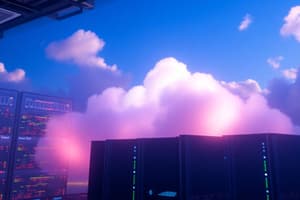Podcast
Questions and Answers
What is the first step in the VMware Cloud Foundation deployment process?
What is the first step in the VMware Cloud Foundation deployment process?
- Deploy VMware Cloud Builder Appliance (correct)
- Initiate the automated bring-up process
- Prepare ESXi Hosts for VMware Cloud Foundation
- Upload the deployment parameter workbook
What does the deployment parameters workbook define?
What does the deployment parameters workbook define?
- User access permissions
- Hardware compatibility settings
- Software licensing agreements
- Network information and host details (correct)
What happens after the deployment parameters workbook is uploaded?
What happens after the deployment parameters workbook is uploaded?
- A JSON file is generated for the bring-up process (correct)
- External certificates are automatically generated
- A manual configuration process starts
- The deployment is permanently halted
What is required for hosts added after bring-up if external certificates are used for ESXi?
What is required for hosts added after bring-up if external certificates are used for ESXi?
Which component is responsible for validating the provided network information during deployment?
Which component is responsible for validating the provided network information during deployment?
What does the term 'bring-up' refer to in the context of VMware Cloud Foundation?
What does the term 'bring-up' refer to in the context of VMware Cloud Foundation?
Which types of certificates can be used during the deployment of VMware Cloud Foundation?
Which types of certificates can be used during the deployment of VMware Cloud Foundation?
What is the purpose of the --force option in SoS Utility?
What is the purpose of the --force option in SoS Utility?
Which option prevents the removal of output from a previous log collection run?
Which option prevents the removal of output from a previous log collection run?
What does the --setup-json SETUP_JSON option allow you to do?
What does the --setup-json SETUP_JSON option allow you to do?
Which option is used to collect logs specifically from ESXi hosts?
Which option is used to collect logs specifically from ESXi hosts?
What does the --log-folder LOGFOLDER option specify?
What does the --log-folder LOGFOLDER option specify?
What should be entered if there is only one DNS server during the VMware Cloud Foundation setup?
What should be entered if there is only one DNS server during the VMware Cloud Foundation setup?
What is the purpose of the FIPS security mode in VMware Cloud Foundation?
What is the purpose of the FIPS security mode in VMware Cloud Foundation?
During the setup, what information needs to be provided for the NTP servers?
During the setup, what information needs to be provided for the NTP servers?
What should the DNS Zone Name reflect in VMware Cloud Foundation?
What should the DNS Zone Name reflect in VMware Cloud Foundation?
Which of the following parameters can be modified after the VMware Cloud Foundation bring-up?
Which of the following parameters can be modified after the VMware Cloud Foundation bring-up?
What does enabling the Customer Experience Improvement Program (CEIP) during setup allow?
What does enabling the Customer Experience Improvement Program (CEIP) during setup allow?
What should be selected if you wish to activate FIPS security mode during deployment?
What should be selected if you wish to activate FIPS security mode during deployment?
Which of the following describes what FIPS 140-2 specifies?
Which of the following describes what FIPS 140-2 specifies?
If you have two NTP servers, what information is required for each during the setup?
If you have two NTP servers, what information is required for each during the setup?
What is necessary when selecting 'Yes' in the License Keys section during deployment?
What is necessary when selecting 'Yes' in the License Keys section during deployment?
What happens if you choose 'No' during the license key selection?
What happens if you choose 'No' during the license key selection?
What should you ensure about the license key when using the per-TiB license for vSAN?
What should you ensure about the license key when using the per-TiB license for vSAN?
What must be resolved for the deployment to succeed regarding host names and IP addresses?
What must be resolved for the deployment to succeed regarding host names and IP addresses?
What type of license key must also be added if using a solution license key?
What type of license key must also be added if using a solution license key?
What does VMware Cloud Builder do with the provided host name and DNS zone?
What does VMware Cloud Builder do with the provided host name and DNS zone?
What is expected in the Deploy Parameters Worksheet for host name entries?
What is expected in the Deploy Parameters Worksheet for host name entries?
What is a critical action required after bring-up if deployed in evaluation mode?
What is a critical action required after bring-up if deployed in evaluation mode?
What is a consequence of failing DNS validation during the deployment process?
What is a consequence of failing DNS validation during the deployment process?
What type of licensing detail is directly related to vSAN during deployment?
What type of licensing detail is directly related to vSAN during deployment?
What must you select to enable vSAN Express Storage Architecture (ESA) for the first cluster in the management domain?
What must you select to enable vSAN Express Storage Architecture (ESA) for the first cluster in the management domain?
What requirement must be fulfilled for creating additional vSAN ESA clusters after bringup?
What requirement must be fulfilled for creating additional vSAN ESA clusters after bringup?
Which flash device characteristic is essential for vSAN ESA?
Which flash device characteristic is essential for vSAN ESA?
Which architecture allows the use of deduplication and compression settings specified in vSAN storage policies?
Which architecture allows the use of deduplication and compression settings specified in vSAN storage policies?
What is a requirement for a host contributing storage in a vSAN ESA cluster?
What is a requirement for a host contributing storage in a vSAN ESA cluster?
What must be ensured concerning the ESXi hosts for compatibility with vSAN ESA?
What must be ensured concerning the ESXi hosts for compatibility with vSAN ESA?
What happens if 'No' is selected for enabling vSAN ESA?
What happens if 'No' is selected for enabling vSAN ESA?
Which of the following is true about the use of vLCM images with vSAN ESA?
Which of the following is true about the use of vLCM images with vSAN ESA?
Which statement is incorrect regarding the capabilities of vSAN ESA?
Which statement is incorrect regarding the capabilities of vSAN ESA?
What does the phrase 'vSAN ESA is not supported with vLCM baselines' imply?
What does the phrase 'vSAN ESA is not supported with vLCM baselines' imply?
What is the maximum VLAN ID that can be entered for the NSX host overlay network?
What is the maximum VLAN ID that can be entered for the NSX host overlay network?
A host with four pNICs requires three IP addresses in the static IP pool for host overlay traffic.
A host with four pNICs requires three IP addresses in the static IP pool for host overlay traffic.
What is the purpose of external NTP sources in VMware Cloud Foundation?
What is the purpose of external NTP sources in VMware Cloud Foundation?
Enter _____ notation to specify the network range in the NSX Host Overlay network.
Enter _____ notation to specify the network range in the NSX Host Overlay network.
Match the following components with their respective descriptions:
Match the following components with their respective descriptions:
What cmdlet is used in PowerCLI to generate a custom ISO?
What cmdlet is used in PowerCLI to generate a custom ISO?
VSphere Lifecycle Manager can be used to create a custom ISO from a single ESXi image.
VSphere Lifecycle Manager can be used to create a custom ISO from a single ESXi image.
Which file format is required to be imported into the vSphere Lifecycle Manager depot as part of customization?
Which file format is required to be imported into the vSphere Lifecycle Manager depot as part of customization?
The command to create a custom ISO specifies the path to the _______ file.
The command to create a custom ISO specifies the path to the _______ file.
Match the following components with their descriptions:
Match the following components with their descriptions:
What is the purpose of the -Destination parameter in the New-IsoImage cmdlet?
What is the purpose of the -Destination parameter in the New-IsoImage cmdlet?
It is necessary to create a temporary cluster to export a vSphere Lifecycle Manager image as an ISO.
It is necessary to create a temporary cluster to export a vSphere Lifecycle Manager image as an ISO.
What should you do if the ESXi version specified in the BOM is not available in the Select Version drop-down menu?
What should you do if the ESXi version specified in the BOM is not available in the Select Version drop-down menu?
What network configuration settings are required when installing ESXi interactively?
What network configuration settings are required when installing ESXi interactively?
You need to use a vendor-specific ISO file to create a custom ESXi ISO image.
You need to use a vendor-specific ISO file to create a custom ESXi ISO image.
The output custom ISO file created by New-IsoImage will be saved in the specified _______ path.
The output custom ISO file created by New-IsoImage will be saved in the specified _______ path.
What does the Active/Standby configuration of DPUs provide?
What does the Active/Standby configuration of DPUs provide?
What command in VMware PowerCLI is used to get the base image version from the ESXi patch zip file?
What command in VMware PowerCLI is used to get the base image version from the ESXi patch zip file?
Which of the following is NOT a step in the process of creating a custom ESXi ISO using vSphere Lifecycle Manager?
Which of the following is NOT a step in the process of creating a custom ESXi ISO using vSphere Lifecycle Manager?
Each DPU in an independent configuration is connected to the same vSphere Distributed Switch.
Each DPU in an independent configuration is connected to the same vSphere Distributed Switch.
You must have at least VMware PowerCLI version _____ to create a custom ISO.
You must have at least VMware PowerCLI version _____ to create a custom ISO.
What is the first step involved in installing ESXi on VMware Cloud Foundation Hosts?
What is the first step involved in installing ESXi on VMware Cloud Foundation Hosts?
Match the following commands with their purpose:
Match the following commands with their purpose:
Where can you download ESXi patches?
Where can you download ESXi patches?
DPUs can be utilized in a ________ configuration to provide redundancy.
DPUs can be utilized in a ________ configuration to provide redundancy.
Match the DPU configuration with its purpose:
Match the DPU configuration with its purpose:
The software spec used to create the custom ISO is an XML file.
The software spec used to create the custom ISO is an XML file.
What type of file must you download from the Broadcom Support Portal for the ESXi patch?
What type of file must you download from the Broadcom Support Portal for the ESXi patch?
What needs to be ensured before configuring the network on VMware Cloud Foundation Hosts?
What needs to be ensured before configuring the network on VMware Cloud Foundation Hosts?
You need to ensure that the new hosts use the later version of ESXi if they have been async patched to a version _____ than the BOM.
You need to ensure that the new hosts use the later version of ESXi if they have been async patched to a version _____ than the BOM.
The Planning and Preparation Workbook is optional for the SDDC access process.
The Planning and Preparation Workbook is optional for the SDDC access process.
What should each ESXi host's network port group be configured with?
What should each ESXi host's network port group be configured with?
Before preparing hosts for a VI workload domain, you must verify the ________ Checklist sheet.
Before preparing hosts for a VI workload domain, you must verify the ________ Checklist sheet.
Which of the following is NOT a prerequisite for installing ESXi?
Which of the following is NOT a prerequisite for installing ESXi?
What is a requirement for the VMware Cloud Builder appliance to function correctly during deployment?
What is a requirement for the VMware Cloud Builder appliance to function correctly during deployment?
The static IP address for the VMware Cloud Builder appliance can be configured after deployment.
The static IP address for the VMware Cloud Builder appliance can be configured after deployment.
What is the minimum password length required for the admin account during the deployment process?
What is the minimum password length required for the admin account during the deployment process?
On the Select networks dialog box, the value for Network mappings must be set to ______.
On the Select networks dialog box, the value for Network mappings must be set to ______.
Match the following steps with their corresponding actions during VMware Cloud Builder deployment.
Match the following steps with their corresponding actions during VMware Cloud Builder deployment.
Which special characters are supported in the admin password during the VMware Cloud Builder setup?
Which special characters are supported in the admin password during the VMware Cloud Builder setup?
Powering on the VMware Cloud Builder appliance automatically is an optional setting during deployment.
Powering on the VMware Cloud Builder appliance automatically is an optional setting during deployment.
Flashcards
VMware Cloud Builder
VMware Cloud Builder
A virtual appliance used to deploy and configure the initial cluster of the management domain and transfer control over the infrastructure to SDDC Manager.
Deployment Parameters Workbook
Deployment Parameters Workbook
A document containing network details, host information, and other configurations required for deploying VMware Cloud Foundation.
Bring Up
Bring Up
The process of setting up and initializing a VMware Cloud Foundation environment.
JSON File
JSON File
Signup and view all the flashcards
Management Domain
Management Domain
Signup and view all the flashcards
External Certificates
External Certificates
Signup and view all the flashcards
External Certificates for ESXi Hosts
External Certificates for ESXi Hosts
Signup and view all the flashcards
DNS Server #1
DNS Server #1
Signup and view all the flashcards
DNS Server #2
DNS Server #2
Signup and view all the flashcards
NTP Server #1
NTP Server #1
Signup and view all the flashcards
NTP Server #2
NTP Server #2
Signup and view all the flashcards
DNS Zone Name
DNS Zone Name
Signup and view all the flashcards
Customer Experience Improvement Program (CEIP)
Customer Experience Improvement Program (CEIP)
Signup and view all the flashcards
FIPS Security Mode
FIPS Security Mode
Signup and view all the flashcards
FIPS 140-2
FIPS 140-2
Signup and view all the flashcards
License Now
License Now
Signup and view all the flashcards
SoS Utility - --force
SoS Utility - --force
Signup and view all the flashcards
SoS Utility - --history
SoS Utility - --history
Signup and view all the flashcards
SoS Utility - --log-dir
SoS Utility - --log-dir
Signup and view all the flashcards
SoS Utility - --setup-json
SoS Utility - --setup-json
Signup and view all the flashcards
SoS Utility - --skip-known-host-check
SoS Utility - --skip-known-host-check
Signup and view all the flashcards
License Keys
License Keys
Signup and view all the flashcards
License Key Validity
License Key Validity
Signup and view all the flashcards
License Key Audit
License Key Audit
Signup and view all the flashcards
vSAN Per-TiB License
vSAN Per-TiB License
Signup and view all the flashcards
Evaluation Mode
Evaluation Mode
Signup and view all the flashcards
Switching to Licensed Mode
Switching to Licensed Mode
Signup and view all the flashcards
vSphere Client License Management
vSphere Client License Management
Signup and view all the flashcards
Separate vSAN License Key
Separate vSAN License Key
Signup and view all the flashcards
Deploy Parameters Worksheet
Deploy Parameters Worksheet
Signup and view all the flashcards
Host Name and DNS Zone
Host Name and DNS Zone
Signup and view all the flashcards
What is vSAN ESA?
What is vSAN ESA?
Signup and view all the flashcards
What is vSAN OSA?
What is vSAN OSA?
Signup and view all the flashcards
Enable vSAN-ESA
Enable vSAN-ESA
Signup and view all the flashcards
What is the vSAN HCL JSON File?
What is the vSAN HCL JSON File?
Signup and view all the flashcards
Why is vLCM Required for vSAN ESA?
Why is vLCM Required for vSAN ESA?
Signup and view all the flashcards
When is vSAN ESA Suitable?
When is vSAN ESA Suitable?
Signup and view all the flashcards
When is vSAN OSA Suitable?
When is vSAN OSA Suitable?
Signup and view all the flashcards
How do vSAN ESA and OSA differ in Storage Pools?
How do vSAN ESA and OSA differ in Storage Pools?
Signup and view all the flashcards
Management Domain and vSAN Architecture
Management Domain and vSAN Architecture
Signup and view all the flashcards
Can vSAN Clusters Change from ESA to OSA?
Can vSAN Clusters Change from ESA to OSA?
Signup and view all the flashcards
Management Network
Management Network
Signup and view all the flashcards
SDDC Manager
SDDC Manager
Signup and view all the flashcards
NSX-T
NSX-T
Signup and view all the flashcards
vSAN
vSAN
Signup and view all the flashcards
Creating a Custom ESXi ISO Image
Creating a Custom ESXi ISO Image
Signup and view all the flashcards
Software Spec
Software Spec
Signup and view all the flashcards
Get-DepotBaseImages
Get-DepotBaseImages
Signup and view all the flashcards
Get-DepotAddons
Get-DepotAddons
Signup and view all the flashcards
Synchronous Patching
Synchronous Patching
Signup and view all the flashcards
Asynchronous Patching
Asynchronous Patching
Signup and view all the flashcards
OEM Add-on
OEM Add-on
Signup and view all the flashcards
ESXi Patch
ESXi Patch
Signup and view all the flashcards
ESXi OEM Add-on
ESXi OEM Add-on
Signup and view all the flashcards
High Availability with DPUs
High Availability with DPUs
Signup and view all the flashcards
Independent DPUs for Offload
Independent DPUs for Offload
Signup and view all the flashcards
ESXi Installation on VMware Cloud Foundation Hosts
ESXi Installation on VMware Cloud Foundation Hosts
Signup and view all the flashcards
Network Configuration on ESXi Hosts
Network Configuration on ESXi Hosts
Signup and view all the flashcards
Configuring Virtual Machine Network Port Group
Configuring Virtual Machine Network Port Group
Signup and view all the flashcards
DPU Configuration for High Availability
DPU Configuration for High Availability
Signup and view all the flashcards
DPU Configuration for Offload Capacity
DPU Configuration for Offload Capacity
Signup and view all the flashcards
Management Domain: The Control Center
Management Domain: The Control Center
Signup and view all the flashcards
ESXi ISO Download for VMware Cloud Foundation
ESXi ISO Download for VMware Cloud Foundation
Signup and view all the flashcards
SDDC Access Host: The Gateway to the Data Center
SDDC Access Host: The Gateway to the Data Center
Signup and view all the flashcards
What is a Static IP Pool for NSX Host Overlay?
What is a Static IP Pool for NSX Host Overlay?
Signup and view all the flashcards
What is a Static IP Pool for NSX Host Overlay?
What is a Static IP Pool for NSX Host Overlay?
Signup and view all the flashcards
What is "Bring Up" in VMware Cloud Foundation?
What is "Bring Up" in VMware Cloud Foundation?
Signup and view all the flashcards
Study Notes
VMware Cloud Foundation Deployment Guide
- VMware Cloud Foundation 5.2 deployment guide
- Technical documentation available at
https://docs.vmware.com/ - Copyright 2015-2024 Broadcom, all rights reserved
- "Broadcom" refers to Broadcom Inc. and/or subsidiaries
- All trademarks, trade names, service marks, and logos belong to their respective companies.
Contents
- About the VMware Cloud Foundation Deployment Guide (page 4)
- Preparing your Environment for VMware Cloud Foundation (page 6)
- Environment must meet target prerequisites and be in a specific starting state.
- Configure necessary infrastructure components.
- Deploying VMware Cloud Foundation (page 7)
- Deploy VMware Cloud Builder Appliance (page 8)
- Deploying a virtual appliance to configure the first management domain cluster.
- Validates network details (DNS, VLANs, IP addresses).
- Prepare ESXi Hosts (page 10)
- Create a Custom ISO Image for ESXi (page 11)
- Create Custom ESXi ISO Image Using VMware PowerCLI (page 11)
- Create Custom ESXi ISO Image Using vSphere Lifecycle Manager (page 13)
- Use vSphere Lifecycle Manager for custom ISO creation if vCenter access is available.
- Install ESXi Interactively and Configure Hosts (page 13)
- Install ESXi on host(s).
- Configure management network, DNS, and NTP services.
- Configure the Network (page 15)
- Configure network adapter (vmkO) and VLAN.
- Configure IP address, subnet mask, gateway, DNS server, and FQDN for ESXi host.
- Configure NTP (page 17)
- Configure NTP service to avoid time synchronization issues.
- Regenerate Self-Signed Certificate (page 18)
- Regenerate self-signed certificates for ESXi host after configuring identity.
- Configure ESXi Hosts with Signed Certificates (page 18)
- Add external CA-signed certificates to ESXi hosts if required by corporate policy.
- Deploy VMware Cloud Builder Appliance (page 8)
- Troubleshooting VMware Cloud Foundation Deployment (page 37)
- VMware Cloud Builder Log Files (page 37)
- Log files for various components (JsonGenerator, Bringup service...).
- Using the SoS Utility (page 38)
- Command-line utility for troubleshooting deployment issues.
- VMware Cloud Builder Log Files (page 37)
- VMware Cloud Foundation Glossary (page 43)
Intended Audience
- Data center cloud administrators deploying VMware Cloud Foundation
- Familiar with virtualization and software-defined data centers
- Familiar with networking concepts (uplinks, NICs, IP networks)
- Familiar with hardware components (Top-of-Rack (ToR) switches, inter-rack switches, servers, direct-attached storage, cables, power supplies)
- Familiar with vSphere Client for virtual machines
Related Publications
- Getting Started with VMware Cloud Foundation (high-level overview)
- Planning and Preparation Workbook (detailed software, tools, and external services)
- VMware Cloud Foundation Administration Guide (administering and operating the system)
- VCF Import Tool (convert existing vSphere cluster to management domain)
Preparing your Environment
- Environment must meet target prerequisites and be in a specific starting state.
- Prepare the necessary infrastructure components.
Studying That Suits You
Use AI to generate personalized quizzes and flashcards to suit your learning preferences.
Related Documents
Description
Test your knowledge on the VMware Cloud Foundation deployment process with this quiz. Explore essential steps, parameters, and components involved in successful deployment, including the significance of certificates and network validation. Perfect for individuals preparing for VMware certifications or professionals enhancing their skills in cloud infrastructure.



